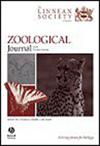中生代孑遗种智利蝇属(双翅目,蝇科)的进化史和生物地理分布
IF 3
2区 生物学
Q1 ZOOLOGY
引用次数: 0
摘要
本研究提出了新的发现,拓展了我们对石灰华亚科(Limoniidae subfamily Limnophilinae)进化史和多样性的认识,特别关注了孑遗属Chilelimnophila。在化石记录中,蝶形目蝶形亚科有很多物种被认为是现代动物群中的孑遗种。我们的研究是基于在白垩纪西班牙琥珀和克钦琥珀中发现的第一批蝶形目化石标本。通过这些新材料,我们建立了一个新的亚属 Chilelimnophila (Ribeironia) Krzemiński, Kania-Kłosok et Arillo, subgen:Chilelimnophila (Ribeironia) amorimi Krzemiński, Kania-Kłosok et Arillo, sp. nov.、Chilelimnophila (Chilelimnophila) wangi Krzemiński, Kania-Kłosok et Arillo, sp. nov.和Chilelimnophila (Chilelimnophila) parva Krzemiński, Kania-Kłosok et Arillo, sp. nov.这项研究还大大扩展了该属的地层范围,提供了该属早在早白垩世时期就已存在的证据。对蝶形目蝶形亚科(Limnophilinae)中的智利蝶形亚科(Chilelimnophila)及相关属的形态和系统发育分析,为了解这些生物的进化关系提供了宝贵的资料。此外,我们的研究还强调了白垩纪西班牙和克钦琥珀地层的独特环境条件,这些地层与这些生物目前的栖息地有很大不同。本文章由计算机程序翻译,如有差异,请以英文原文为准。
The evolutionary history and biogeographical distribution of the Mesozoic relic genus Chilelimnophila (Diptera, Limoniidae)
This study presents novel findings that expand our understanding of the evolutionary history and diversity of the Limoniidae subfamily Limnophilinae, with a specific focus on the relict genus Chilelimnophila. The family Limoniidae is well documented in the fossil record, with many species considered relicts in the modern fauna. Our study is based on the discovery of the first fossil specimens of Chilelimnophila in both Cretaceous Spanish and Kachin amber. The new materials have allowed the establishment of a new subgenus Chilelimnophila (Ribeironia) Krzemiński, Kania-Kłosok et Arillo, subgen. nov. and three new species: Chilelimnophila (Ribeironia) amorimi Krzemiński, Kania-Kłosok et Arillo, sp. nov., Chilelimnophila (Chilelimnophila) wangi Krzemiński, Kania-Kłosok et Arillo, sp. nov., and Chilelimnophila (Chilelimnophila) parva Krzemiński, Kania-Kłosok et Arillo, sp. nov. This research also significantly extends the stratigraphic range of the genus, providing evidence of its existence dating back to the Early Cretaceous period. The morphology and phylogenetic analysis of Chilelimnophila and related genera within the Limoniidae subfamily Limnophilinae provide valuable insights into the evolutionary relationships of these organisms. Furthermore, our research highlights the unique environmental conditions of Cretaceous Spanish and Kachin amber formations, which differ significantly from the current habitat of these organisms.
求助全文
通过发布文献求助,成功后即可免费获取论文全文。
去求助
来源期刊
CiteScore
6.50
自引率
10.70%
发文量
116
审稿时长
6-12 weeks
期刊介绍:
The Zoological Journal of the Linnean Society publishes papers on systematic and evolutionary zoology and comparative, functional and other studies where relevant to these areas. Studies of extinct as well as living animals are included. Reviews are also published; these may be invited by the Editorial Board, but uninvited reviews may also be considered. The Zoological Journal also has a wide circulation amongst zoologists and although narrowly specialized papers are not excluded, potential authors should bear that readership in mind.

 求助内容:
求助内容: 应助结果提醒方式:
应助结果提醒方式:


